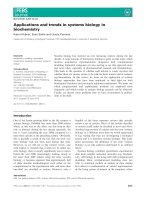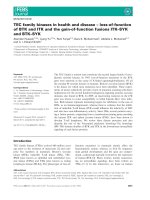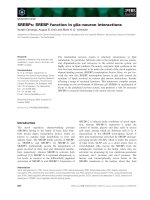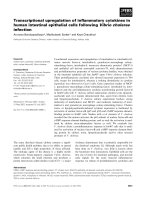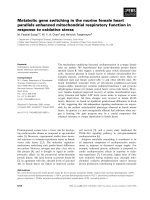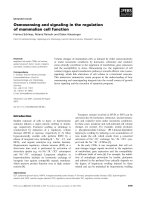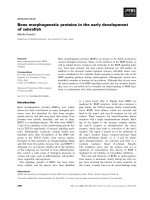Báo cáo khoa học: "Identifying Repair Targets in Action Control Dialogue" pdf
Bạn đang xem bản rút gọn của tài liệu. Xem và tải ngay bản đầy đủ của tài liệu tại đây (240.35 KB, 8 trang )
Identifying Repair Targets in Action Control Dialogue
Kotaro Funakoshi and Takenobu Tokunaga
Department of Computer Science,
Tokyo Institute of Technology
2-12-1 Oookayama Meguro, Tokyo, JAPAN
{koh,take}@cl.cs.titech.ac.jp
Abstract
This paper proposes a method for deal-
ing with repairs in action control dialogue
to resolve participants’ misunderstanding.
The proposed method identifies the re-
pair target based on common grounding
rather than surface expressions. We extend
Traum’s grounding act model by introduc-
ing degree of groundedness, and partial
and mid-discourse unit grounding. This
paper contributes to achieving more natu-
ral human-machine dialogue and instanta-
neous and flexible control of agents.
1 Introduction
In natural language dialogue, misunderstanding
and its resolution is inevitable for the natural
course of dialogue. The past research dealing
with misunderstanding has been focused on the di-
alogue involving only utterances. In this paper,
we discuss misunderstanding problem in the di-
alogue involving participant’s actions as well as
utterances. In particular, we focus on misunder-
standing in action control dialogue.
Action control dialogue is a kind of task-
oriented dialogue in which a commander con-
trols the actions
1
of other agents called followers
through verbal interaction.
This paper deals with disagreement repair ini-
tiation utterances
2
(DRIUs) which are used by
commanders to resolve followers’ misunderstand-
ings
3
, or to correct commanders’ previous erro-
neous utterances. These are so called third-turn
1
We use the term “action” for the physical behavior of
agents except for speaking.
2
This denomination is lengthy and may be still controver-
sial. However we think this is most descriptively adequate for
the moment.
3
Misunderstanding is a state where miscommunication
has occurred but participants are not aware of this, at least
initially (Hirst et al., 1994).
repair (Schegloff, 1992). Unlike in ordinary dia-
logue consisting of only utterances, in action con-
trol dialogue, followers’ misunderstanding could
be manifested as their inappropriate actions in re-
sponse to a given command.
Let us look at a sample dialogue (1.1 – 1.3). Ut-
terance (1.3) is a DRIU for repairing V’s mis-
understanding of command (1.1) which is mani-
fested by his action performed after saying “OK”
in (1.2).
(1.1) U: Put the red book on the shelf to the right.
(1.2) V: OK. <V performs the action>
(1.3) U: Not that.
It is not easy for machine agents to under-
stand DRIUs because they can sometimes be so
elliptical and context-dependent that it is difficult
to apply traditional interpretation methodology to
DRIUs.
In the rest of this paper, we describe the dif-
ficulty of understanding DRIUs and propose a
method to identify repair targets. The identifica-
tion of repair targets plays a key role in under-
standing DRIUs and this paper is intensively fo-
cused on this issue.
2 Difficulty of Understanding DRIUs
Understanding a DRIU consists of repair tar-
get identification and repair content interpretation.
Repair target identification identifies a target to be
repaired by the speaker’s utterance. Repair con-
tent interpretation recovers the speaker’s intention
by replacing the identified repair target with the
correct one.
One of the major source of difficulties in un-
derstanding DRIUs is that they are often elliptical.
Repair content interpretation depends heavily on
repair targets but the information to identify re-
pair targets is not always mentioned explicitly in
DRIUs.
Let us look at dialogue (1.1 – 1.3) again. The
DRIU (1.3) indicates that V failed to identify U’s
intended object in utterance (1.1). However, (1.3)
does not explicitly mention the repair target, i.e.,
either book or shelf in this case.
The interpretation of (1.3) changes depending
on when it is uttered. More specifically, the inter-
pretation depends on the local context and the sit-
uation when the DRIU is uttered. If (1.3) is uttered
when V is reaching for a book, it would be natu-
ral to consider that (1.3) is aimed at repairing V’s
interpretation of “the book”. On the other hand,
if (1.3) is uttered when V is putting the book on a
shelf, it would be natural to consider that (1.3) is
aimed at repairing V’s interpretation of “the shelf
to the right”.
Assume that U uttered (1.3) when V was putting
a book in his hand on a shelf, how can V identify
the repair target as shelf instead of book? This pa-
per explains this problem on the basis of common
grounding (Traum, 1994; Clark, 1996). Common
grounding or shortly grounding is the process of
building mutual belief among a speaker and hear-
ers through dialogue. Note that in action control
dialogue, we need to take into account not only
utterances but also followers’ actions. To identify
repair targets, we keep track of states of grounding
by treating followers’ actions as grounding acts
(see Section 3). Suppose V is placing a book in
his hand on a shelf. At this moment, V’s inter-
pretation of “the book” in (1.1) has been already
grounded, since U did not utter any DRIU when
V was taking the book. This leads to the interpre-
tation that the repair target of (1.1) is shelf rather
than already grounded book.
3 Grounding
This section briefly reviews the grounding acts
model (Traum, 1994) which we adopted in our
framework. We will extend the grounding act
model by introducing degree of groundedness that
have a quaternary distinction instead of the orig-
inal binary distinction. The notions of partial
grounding and mid-discourse unit grounding are
also introduced for dealing with action control di-
alogue.
3.1 Grounding Acts Model
The grounding acts model is a finite state transi-
tion model to dynamically compute the state of
grounding in a dialogue from the viewpoint of
each participant.
This theory models the process of grounding
with a theoretical construct, namely the discourse
unit (DU). A DU is a sequence of utterance units
(UUs) assigned grounding acts (GAs). Each UU
in a dialogue has at least one GA, except fillers or
several cue phrases, which are considered useful
for turn taking but not for grounding. Each DU
has an initiator (I) who opened it, and other par-
ticipants of that DU are called responders (R).
Each DU is in one of seven states listed in Ta-
ble 1 at a time. Given one of GAs shown in Table 2
as an input, the state of DU changes according to
the current state and the input. A DU starts with
a transition from initial state S to state 1, and fin-
ishes at state F or D. DUs in state F are regarded
as grounded.
Analysis of the grounding process for a sam-
ple dialogue is illustrated in Figure 1. Speaker B
can not understand the first utterance by speaker
A and requests a repair (ReqRep-R) with his ut-
terance. Responding to this request, A makes a
repair (Repair-I). Finally, B acknowledges to
show he has understood the first utterance and the
discourse unit reaches the final state, i.e., state F.
State Description
S Initial state
1
Ongoing
2
Requested a repair by a responder
3
Repaired by a responder
4
Requested a repair by the initiator
F
Finished
D
Canceled
Table 1: DU states
Grounding act Description
Initiate Begin a new DU
Continue
Add related content
Ack
Present evidences of understanding
Repair
Correct misunderstanding
ReqRepair
Request a repair act
ReqAck
Request an acknowledge act
Cancel
Abandon the DU
Table 2: Grounding acts
UU DU1
A : Can I speak to Jim Johnstone
please?
Init-I 1
B : Senior?
ReqRep-R 2
A : Yes
Repair-I 1
B : Yes
Ack-R F
Figure 1: An example of grounding (Ishizaki and
Den, 2001)
178
3.2 Degree of Groundedness and Evidence
Intensity
As Traum admitted, the binary distinction between
grounded and ungrounded in the grounding acts
model is an oversimplification (Traum, 1999). Re-
pair target identification requires more finely de-
fined degree of groundedness. The reason for this
will be elucidated in Section 5.
Here, we will define the four levels of evidence
intensity and equate these with degrees of ground-
edness, i.e., if an utterance is grounded with evi-
dence of level N intensity, the degree of ground-
edness of the utterance is regarded as level N.
(2) Levels of evidence intensity
Level 0: No evidence (i.e., not grounded).
Level 1: The evidence shows that the re-
sponder thinks he understood the utter-
ance. However, it does not necessar-
ily mean that the responder understood
it correctly. E.g., the acknowledgment
“OK” in response to the request “turn to
the right.”
Level 2: The evidence shows that the re-
sponder (partially) succeeded in trans-
ferring surface level information. It does
not yet ensure that the interpretation of
the surface information is correct. E.g.,
the repetition “to the right” in response
to the request “turn to the right.”
Level 3: The evidence shows that the re-
sponder succeeded in interpretation.
E.g., turning to the right as the speaker
intended in response to the request “turn
to the right.”
3.3 Partial and mid-DU Grounding
In Traum’s grounding model, the content of a DU
is uniformly grounded. However, things in the
same DU should be more finely grounded at var-
ious levels individually. For example, if one ac-
knowledged by saying “to the right” in response
to the command “put the red chair to the right of
the table”, to
the right of should be regarded as
grounded at Level 2 even though other parts of the
request are grounded at Level 1.
In addition, in Traum’s model, the content of a
DU is grounded all at once when the DU reaches
the final state, F. However, some elements in a DU
can be grounded even though the DU has not yet
reached state F. For example, if one requested a
repair as “to the right of what?” in response to
the command “put the red chair to the right of
the table”, to
the right of should be regarded as
grounded at level 2 even though table has not yet
been grounded.
Although Traum admitted these problems ex-
isted in his model, he retained it for the sake of
simplicity. However, such partial and mid-DU
grounding is necessary to identify repair targets.
We will describe the usage of these devices to
identify repair targets in Section 5. In brief, when
a level 3 evidence is presented by the follower and
negative feedback (i.e., DRIUs) is not provided by
the commander, only propositions supported by
the evidence are considered to be grounded even
though the DU has not yet reached state F.
4 Treatment of Actions in Dialogue
In general, past work on discourse has targeted di-
alogue consisting of only utterances, or has con-
sidered actions as subsidiary elements. In contrast,
this paper targets action control dialogue, where
actions are considered to be primary elements of
dialogue as well as utterances.
Two issues have to be mentioned for handling
action control dialogue in the conventional se-
quential representation as in Figure 1. We will in-
troduce assumptions (3) and (4) as shown below.
Overlap between utterances and actions
Actions in dialogue do not generally obey turn
allocation rules as Clark pointed out (Clark, 1996).
In human-human action control dialogue, follow-
ers often start actions in the middle of a comman-
der’s utterance. This makes it difficult to analyze
discourse in sequential representation. Given this
fact, we impose the three assumptions on follow-
ers as shown in (3) so that followers’ actions will
not overlap the utterances of commanders. These
requirements are not unreasonable as long as fol-
lowers are machine agents.
(3) Assumptions on follower’s actions
(a) The follower will not commence action
until turn taking is allowed.
(b) The follower immediately stops the ac-
tion when the commander interrupts
him.
(c) The follower will not make action as pri-
mary elements while speaking.
4
4
We regard gestures such as pointing as secondary ele-
179
Hierarchy of actions
An action can be composed of several sub-
actions, thus has a hierarchical structure. For ex-
ample, making tea is composed of boiling the wa-
ter, preparing the tea pot, putting tea leaves in the
pot, and pouring the boiled water into it, and so
on. To analyze actions in dialogue as well as ut-
terances in the traditional way, a unit of analysis
should be determined. We assume that there is a
certain granularity of action that human can recog-
nize as primitive. These actions would correspond
to basic verbs common to humans such as “walk”,
“grasp”, “look”, etc.We call these actions funda-
mental actions and consider them as UUs in action
control dialogue.
(4) Assumptions on fundamental actions
In the hierarchy of actions, there is a cer-
tain level consisting of fundamental actions
that human can commonly recognize as prim-
itives. Fundamental actions can be treated as
units of primary presentations in an analogy
with utterance units .
5 Repair Target Identification
In this section, we will discuss how to identify the
repair target of a DRIU based on the notion of
grounding. The following discussion is from the
viewpoint of the follower.
Let us look at a sample dialogue (5.1 – 5.5),
where U is the commander and V is the fol-
lower. The annotation Ack
1
-R:F in (5.2) means
that (5.2) has grounding act Ack by the respon-
der (R) for DU1 and the grounding act made DU1
enter state F. The angle bracketed descriptions in
(5.3) and (5.4) indicate the fundamental actions by
V.
Note that thanks to assumption (4) in Section 4,
a fundamental action itself can be considered as a
UU even though the action is performed without
any utterances.
(5.1) U: Put the red ball on the left box. (Init
1
-I:1)
(5.2) V: Sure. (Ack
1
-R:F)
(5.3) V: <V grasps the ball> (Init
2
-I:1)
(5.4) V: <V moves the ball> (Cont
2
-I:1)
(5.5) U: Not that. (Repair
1
-R:3)
The semantic content of (5.1) can be repre-
sented as a set of propositions as shown in (6).
ments when they are presented in parallel with speech. There-
fore, this constraint does not apply to them.
(6) α = Request(U, V, Put(#Agt1, #Obj1, #Dst1))
(a) speechActType(α)=Request
(b) presenter(α)=U
(c) addressee(α)=V
(d) actionType(content(α))=Put
(e) agent(content(α))=#Agt1,
referent(#Agt1)=V
(f) object(content(α))=#Obj1,
referent(#Obj1)=Ball1
(g) destination(content(α))=#Dst1,
referent(#Dst1)=Box1
α represents the entire content of (5.1). Sym-
bols beginning with a lower case letter are func-
tion symbols. For example, (6a) means the speech
act type for α is “Request”. Symbols beginning
with an upper case letter are constants. “Request”
is the name of a speech act type and “Move” is
that of fundamental action respectively. U and V
represents dialogue participants and “Ball1” rep-
resents an entity in the world. Symbols beginning
with # are notional entities introduced in the dis-
course and are called discourse referents. A dis-
course referent represents something referred to
linguistically. During a dialogue, we need to con-
nect discourse referents to entities in the world, but
in the middle of the dialogue, some discourse ref-
erents might be left unconnected. As a result we
can talk about entities that we do not know. How-
ever, when one takes some actions on a discourse
referent, he must identify the entity in t he world
(e.g., an object or a location) corresponding to the
discourse referent. Many problems in action con-
trol dialogue are caused by misidentifying entities
in the world.
Follower V interprets (5.1) to obtain (6), and
prepares an action plan (7) to achieve “Put(#Agt1,
#Obj1, #Dst1)”. Plan (7) is executed downward
from the top.
(7) Plan for Put(#Agt1, #Obj1, #Dst1)
Grasp(#Agt1, #Obj1),
Move(#Agt1, #Obj1, #Dst1),
Release(#Agt1, #Obj1)
Here, (5.1 – 5.5) are reformulated as in (8.1 –
8.5). “Perform” represents performing the action.
(8.1) U: Request(U, V, Put(#Agt1, #Obj1, #Dst1))
(8.2) V: Accept(V, U, α)
(8.3) V: Perform(V, U, Grasp(#Agt1, #Obj1))
180
(8.4) V: Perform(V, U, Move(#Agt1, #Obj1, #Dst1))
(8.5) U: Inform(U, V, incorrect(X))
To understand DRIU (5.5), i.e., (8.5), follower
V has to identify repair target X in (8.5) referred
to as “that” in (5.5). In this case, the repair target
of (5.5) X is “the left box”, i.e., #Dst1.
5
However,
the pronoun “that” cannot be resolved by anaphora
resolution only using textual information.
We treat propositions, or bindings of variables
and values, such as (6a – 6g), as the minimum
granularity of grounding because the identification
of repair targets requires that granularity. We then
make the following assumptions concerning repair
target identification.
(9) Assumptions on repair target identification
(a) Locality of elliptical DRIUs: The target
of an elliptical DRIU that interrupted the
follower’s action is a proposition that is
given an evidence of understanding by
the interrupted action.
(b) Instancy of error detection: A dialogue
participant observes his dialogue con-
stantly and actions presenting strong ev-
idence (Level 3). Thus, when there is an
error, the commander detects it immedi-
ately once an action related to that error
occurs.
(c) Instancy of repairs: If an error is
found, the commander immediately in-
terrupts the dialogue and initiates a re-
pair against it.
(d) Lack of negative evidence as positive
evidence: The follower can determine
that his interpretation is correct if the
commander does not initiates a repair
against the follower’s action related to
the interpretation.
(e) Priority of repair targets: If there are
several possible repair targets, the least
grounded one is chosen.
(9a) assumes that a DRIU can only be ellipti-
cal when it presupposes the use of local context to
identify its target. It also predicts that if the target
of a repair is neither local nor accessible within
local information, the DRIU will not be elliptical
depending on local context but contain explicit and
5
We assume that there is a sufficiently long interval be-
tween the initiations of (5.4) and (5.5).
sufficient information to identify the target. (9b)
and (9c) enable (9a).
Nakano et al. (2003) experimentally confirmed
that we observe negative responses as well as pos-
itive responses in the process of grounding. Ac-
cording to their observations, speakers continue
dialogues if negative responses are not found even
when positive responses are not found. This evi-
dence supports (9d).
An intuitive rationale for (9e) is that an issue
with less proof would more probably be wrong
than one with more proof.
Now let us go through (8.2) to (8.5) again ac-
cording to the assumptions in (9). First, α is
grounded at intensity level 1 by (8.2). Second, V
executes Grasp(#Agt1, #Obj1) at (8.3). Because
V does not observe any negative response from U
even after this action is completed, V considers
that the interpretations of #Agt1 and #Obj1 have
been confirmed and grounded at intensity level 3
according to (9d) (this is the partial and mid-DU
grounding mentioned in Section 3.3). After initiat-
ing Move(#Agt1, #Obj1, #Dst1), V is interrupted
by commander U with (8.5) in the middle of the
action.
V interprets elliptical DRIU (5.5) as “Inform(S,
T, incorrect(X))”, but he cannot identify repair tar-
get X. He tries to identify this from the discourse
state or context. According to (9a), V assumes that
the repair target is a proposition that its interpre-
tation is demonstrated by interrupted action (8.4).
Due to the nature of the word “that”, V knows that
possible candidates are not types of action or the
speech act but discourse referents #Agt1, #Obj1
and #Dst1
6
. Here, #Agt1 and #Obj1 have been
grounded at intensity level 3 by the completion of
(8.3). Now, (9e) tells V that the repair target is
#Dst1, which has only been grounded at intensity
level 1
7
.
(10) below summarizes the method of repair tar-
get identification based on the assumptions in (9).
(10) Repair target identification
6
We have consistently assumed Japanese dialogues in this
paper although examples have been translated into English.
“That” is originally the pronoun “sotti” in Japanese, which
can only refer to objects, locations, or directions, but cannot
refer to actions.
7
There are two propositions concerned with #Dst1:
destination(content(α)) = #Dst1 and referent(#Dst1) = Box1.
However if dest(content(α)) = #Dst1 is not correct, this
means that V grammatically misinterpreted (8.1). It seems
hard to imagine for participants speaking in their mother
tongue and thus one can exclude dest(content(α)) = #Dst1
from the candidates of the repair target.
181
(a) Specify the possible types of the repair
target from the linguistic expression.
(b) List the candidates matching the types
determined in (10a) from the latest pre-
sented content.
(c) Rank candidates based on groundedness
according to (9e) and choose the top
ranking one.
Dependencies between Parameters
The follower prepares an action plan to achieve
the commander’s command as in plan (7). Here,
the planned actions can contain parameters not di-
rectly corresponding to the propositions given by
the commander. Sometimes a selected parameter
by using (10) is not the true target but the depen-
dent of the target. Agents must retrieve the true
target by recognizing dependencies of parameters.
For example, assume a situation where objects
are not within the follower’s reach as shown in
Figure 2. Then, the commander issues command
(6) to the follower (Agent1 in Figure 2) and he
prepares an action plan (11).
(11) Agent1’s plan (partial) for (6) in Figure 2.
Walk(#Agt1, #Dst1),
Grasp(#Agt1, #Obj1),
. . .
The first Walk is a prerequisite action for Grasp
and #Dst1 depends on #Obj1. In this case, if refer-
ent(#Obj1) is Object1 then referent(#Dst1) is Po-
sition1, or if referent(#Obj1) is Object2 then ref-
erent(#Dst1) is Position2. Now, assume that the
commander intends referent(#Obj1) to be Object2
with (6), but the follower interprets this as refer-
ent(#Obj1) = Object1 (i.e., referent(#Dst1) = Po-
sition1) and performs Walk(#Agt1, #Dst1). The
commander then observes the follower moving to-
ward a direction different from his expectation and
infers the follower has misunderstood the target
object. He, then, interrupts the follower with the
utterance “not that” at the timing illustrated in Fig-
ure 3. Because (10c) chooses #Dst2 as the repair
target, the follower must be aware of the depen-
dencies between parameters #Dst1 and #Obj1 to
notice his misidentification of #Obj1.
6 Implementation and Some Problems
We implemented the repair target identification
method described in Section 5 into our prototype
Position1
Agent1
Object1 (wrong)
Object2 (correct)
Position2
Figure 2: Situation with dependent parameters
Time
Walk(#Agt1, #Dst1) Grasp(#Agt1, #Obj1)
" Not that "
Figure 3: Dependency between parameters
dialogue system (Figure 4). The dialogue system
has animated humanoid agents in its visualized 3D
virtual world. Users can command the agent by
speech to move around and relocate objects.
Figure 4: Snapshot of the dialogue system
Because our domain is rather small, current pos-
sible repair targets are agents, objects and goals
of actions. According to the qualitative evalua-
tion of the system through interaction with sev-
eral subjects, most of the repair targets were cor-
rectly identified by the proposed method described
in Section 5. However, through the evaluation, we
found several important problems to be solved as
below.
6.1 Feedback Delay
In a dialogue where participants are paying atten-
tion to each other, the lack of negative feedback
can be considered as positive evidence (see (9d)).
However, it is not clear how long the system needs
to wait to consider the lack of negative feedback as
positive evidence. In some cases, it will be not ap-
propriate to consider the lack of negative feedback
182
as positive evidence immediately after an action
has been completed. Non-linguistic information
such as nodding and gazing should be taken into
consideration to resolve this problem as (Nakano
et al., 2003) proposed.
Positive feedback is also affected by delay.
When one receives feedback shortly after an action
is completed and begins the next action, it may be
difficult to determine whether the feedback is di-
rected to the completed action or to the just started
action.
6.2 Visibility of Actions
The visibility of followers’ actions must be con-
sidered. If the commander cannot observe the fol-
lower’s action due to environmental conditions,
the lack of negative feedback cannot be positive
evidence for grounding.
For example, assume the command “bring me
a big red cup from the next room” is given and
assume that the commander cannot see the inside
of the next room. Because the follower’s funda-
mental action of taking a cup in the next room is
invisible to the commander, it cannot be grounded
at that time. They have to wait for the return of the
follower with a cup.
6.3 Time-dependency of Grounding
Utterances are generally regarded as points on the
time-line in dialogue processing. However, this
approximation cannot be applied to actions. One
action can present evidences for multiple propo-
sitions but it will present these evidences at con-
siderably different time. This affects repair target
identification.
Let us look at an action Walk(#Agt, #Dst),
where agent #Agt walks to destination #Dst. This
action will present evidence for “who is the in-
tended agent (#Agt)” at the beginning. However,
the evidence for “where is the intended position
(#Dst)” will require the action to be completed.
However, if the position intended by the follower
is in a completely different direction from the one
intended by the commander, his misunderstanding
will be evident at a fairly early stage of the action.
6.4 Differences in Evidence Intensities
between Actions
Evidence intensities vary depending on the char-
acteristics of actions. Although the symbolic de-
scription of actions such as (12) and (13) does not
explicitly represent differences in intensity, there
is a significant difference between (12) where
#Agent looks at #Object at a distance, and (13)
where #Agent directly contacts #Object. Agents
must recognize these differences to conform with
human recognition and share the same state of
grounding with participants.
(12) LookAt(#Agent, #Object)
(13) Grasp(#Agent, #Object)
6.5 Other Factors of Confidence in
Understanding
Performing action can provide strong evidence of
understanding and such evidence enables partic-
ipants to have strong confidence in understand-
ing. However, other factors such as linguistic con-
straints (not limited to surface information) and
plan/goal inference can provide confidence in un-
derstanding without grounding. Such factors of
confidence also must be incorporated to explain
some repairs.
Let us see a sample dialogue below, and assume
that follower V missed the word red in (14.3).
(14.1) U: Get the white ball in front of the table.
(14.2) V: OK. <V takes a white ball>
(14.3) U: Put it on the (red) table.
(14.4) V: Sure. <V puts the white ball holding in
his hand on a non-red table>
(14.5) U: I said red.
When commander U repairs V’s misunder-
standing by (14.5), V cannot correctly decide that
the repair target is not “it” but “the (red) table” in
(14.3) by using the proposed method, because the
referent of “it” had already been in V’s hand and
no explicit action choosing a ball was performed
after (14.3). However, in such a situation we seem
to readily doubt misunderstanding of “the table”
because of strong confidence in understanding of
“it” that comes from outside of grounding process.
Hence, we need a unified model of confidence in
understanding that can map different sources of
confidence into one dimension. Such a model is
also useful for clarification management of dia-
logue systems.
7 Discussion
7.1 Advantage of Proposed Method
The method of repair target identification pro-
posed in this paper less relies on surface infor-
mation to identify targets. This is advantageous
183
against some sort of misrecognitions by automatic
speech recognizers and contributes to the robust-
ness of spoken dialogue systems.
Only surface information is generally insuffi-
cient to identify repair targets. For example, as-
sume that there is an agent acting in response to
(15) and his commander interrupts him with (16).
(15) Put the red ball on the table
(16) Sorry, I meant blue
If one tries to identify the repair target with sur-
face information, the most likely candidate will
be “the red ball” because of the lexical similar-
ity. Such methods easily break down. They can-
not deal with (16) after (17). If, however, one pays
attention to the state of grounding as our proposed
method, he can decide which one is likely to be re-
paired “the red ball” or “the green table” depend-
ing on the timing of the DRIU.
(17) Put the red ball on the green table
7.2 Related Work
McRoy and Hirst (1995) addressed the detection
and resolution of misunderstandings on speech
acts using abduction. Their model only dealt with
speech acts and did not achieve our goals.
Ardissono et al. (1998) also addressed the same
problem but with a different approach. Their
model could also handle misunderstanding regard-
ing domain level actions. However, we think that
their model using coherence to detect and resolve
misunderstandings cannot handle DRIUs such as
(8.5), since both possible repairs for #Obj1 and
#Dst1 have the same degree of coherence in their
model.
Although we did not adopt this, the notion of
QUD (questions under discussion) proposed by
Ginzburg (Ginzburg, 1996) would be another pos-
sible approach to explaining the problems ad-
dressed in this paper. It is not yet clear whether
QUD would be better or not.
8 Conclusion
Identifying repair targets is a prerequisite to un-
derstand disagreement repair initiation utterances
(DRIUs). This paper proposed a method to iden-
tify the target of a DRIU for conversational agents
in action control dialogue. We explained how a re-
pair target is identified by using the notion of com-
mon grounding. The proposed method has been
implemented in our prototype system and eval-
uated qualitatively. We described the problems
found in the evaluation and looked at the future
directions to solve these problems.
Acknowledgment
This work was supported in part by the Ministry of
Education, Science, Sports and Culture of Japan as
the Grant-in-Aid for Creative Basic Research No.
13NP0301.
References
L. Ardissono, G. Boella, and R. Damiano. 1998. A
plan based model of misunderstandings in cooper-
ative dialogue. International Journal of Human-
Computer Studies, 48:649–679.
Herbert H. Clark. 1996. Using Language. Cambridge
University Press.
Jonathan Ginzburg. 1996. Interrogatives: ques-
tions, facts and dialogue. In Shalom Lappin, editor,
The Handbook of Contemporary Semantic Theory.
Blackwell, Oxford.
G. Hirst, S. McRoy, P. Heeman, P. Edmonds, and
D. Horton. 1994. Repairing conversational misun-
derstandings and non-understandings. Speech Com-
munication, 15:213–230.
Masato Ishizaki and Yasuharu Den. 2001. Danwa
to taiwa (Discourse and Dialogue). University of
Tokyo Press. (In Japanese).
Susan Weber McRoy and Graeme Hirst. 1995. The re-
pair of speech act misunderstandings by abductive
inference. Computational Linguistics, 21(4):435–
478.
Yukiko Nakano, Gabe Reinstein, Tom Stocky, and Jus-
tine Cassell. 2003. Towards a model of face-to-face
grounding. In Erhard Hinrichs and Dan Roth, edi-
tors, Proceedings of the 41st Annual Meeting of the
Association for Computational Linguistics, pages
553–561.
E. A Schegloff. 1992. Repair after next turn: The
last structurally provided defense of intersubjectiv-
ity in conversation. American Journal of Sociology,
97(5):1295–1345.
David R. Traum. 1994. Toward a Computational
Theory of Grounding. Ph.D. thesis, University of
Rochester.
David R. Traum. 1999. Computational models of
grounding in collaborative systems. In Working
Papers of AAAI Fall Symbosium on Psychological
Models of Communication in Collaborative Systems,
pages 137–140.
184

